Bionic Structure on Complex Surface with Belt Grinding for Electron Beam Welding Seam of Titanium Alloy
Abstract
:1. Introduction
2. Experimental Methods and Devices
2.1. Experimental Scheme
2.2. Experimental Equipment
2.3. Experimental Materials
3. Analysis of Experimental Results
3.1. Analysis of Grinding Surface Quality
3.2. Analysis of Formation Law of Ground Surface
3.3. Analysis of Ground Parameters
4. Conclusions
- (1)
- The experimental platform of titanium alloy EBW with bionic surface grinding was established; two bionic surface geometric models with rib width of 20 μm and 40 μm, and rib height of 3 μm and 10 μm were established to explore the influence of feed speed and belt speed on the bionic surface. If the feeding speed is too high, the rib surface is not obvious; if the belt speed is too high, the ribbed surface is damaged.
- (2)
- Belt polishing improves the quality of the weld surface, making the weld surface and the base material surface form a better and smoother surface; Ra can reach 0.98 μm. The weld margin can also be effectively eliminated. The additional height of the ground weld surface may be less than 0.2 mm, effectively removing the weld surface margin.
- (3)
- The grinding quality of the weld surface is better than that of the weld ridge. With the decrease of vp and vs, the size of the bionic structure formed by grinding decreased, as did the surface structure of the overall bionic. The effect of Fn on Ra is followed by vp then vs.
Author Contributions
Funding
Conflicts of Interest
References
- Kar, J.; Chakrabarti, D.; Roy, S.K.; Roy, G.G. Beam oscillation, porosity formation and fatigue properties of electron beam welded Ti-6Al-4V alloy. J. Mater. Process. Technol. 2019, 266, 165. [Google Scholar] [CrossRef]
- Garud, V.U.; Lakade, S.S.; Bhoite, S.; More, S.; Ingale, S.; Gaikwad, N.; Gavhane, K. Burr Grinder: Advanced & Effective Post Weld Toe Treatment to Optimize Fatigue Life of Welded Structures. In Proceedings of the 2016 International Conference on Electrical, Electronics, and Optimization Techniques (ICEEOT), Chennai, India, 3–5 March 2016; pp. 196–203. [Google Scholar]
- Liu, J.; Gao, X.L.; Zhang, L.J.; Zhang, J.X. Effects of the Heterogeneity in the Electron Beam Welded Joint on Mechanical Properties of Ti6Al4V Alloy. J. Mater. Eng. Perform. 2015, 24, 319. [Google Scholar] [CrossRef]
- Baptista, R.; Infante, V.; Branco, C.M. Study of the fatigue behavior in welded joints of stainless steels treated by weld toe grinding and subjected to salt water corrosion. Int. J. Fatigue 2008, 3, 453–462. [Google Scholar] [CrossRef]
- Lan, Y.; Zhang, W.; Liu, X.; Li, N.; Dai, W. Effects of Welded Pores on Fatigue Life of Titanium Alloy Electron-Beam Welded Joints. In Proceedings of the 2018 Prognostics and System Health Management Conference (PHM-Chongqing), Chongqing, China, 26–28 October 2018; pp. 1144–1148. [Google Scholar]
- Chai, H.; Huang, Y.; Zhao, Y.; Zhang, X.D. Experimental Research on the Abrasive Belt Grinding Titanium Alloy Blade of Aviation Engine. In Proceedings of the 15th International Symposium on Advances in Abrasive Technology (ISAAT2012), Singapore, 25–28 September 2012; Volume 565, pp. 64–69. [Google Scholar]
- Xiao, G.J.; Huang, Y. Adaptive belt precision grinding for the weak rigidity deformation of blisk leading and trailing edge. Adv. Mech. Eng. 2017, 9, 1–12. [Google Scholar] [CrossRef]
- Pandiyan, V.; Murugan, P.; Tjahjowidodo, T.; Caesarendra, W.; Manyar, O.M.; Then, D.J.H. In-process virtual verification of weld seam removal in robotic abrasive belt grinding process using deep learning. Robot. Comput. Integr. Manuf. 2019, 6, 477–487. [Google Scholar] [CrossRef]
- Wang, J.W.; Xu, J.J.; Wang, X.F. A comprehensive study on surface integrity of nickel-based superalloy Inconel 718 under robotic belt grinding. Mater. Manuf. Process. 2019, 34, 61–69. [Google Scholar] [CrossRef]
- Yan, S.J.; Xu, X.H.; Yang, Z.Y. An improved robotic abrasive belt grinding force model considering the effects of cut-in and cut-off. J. Manuf. Process. 2019, 37, 496–508. [Google Scholar] [CrossRef]
- Frohnapfel, B.; Jovanovic, J.; Delgado, A. Experimental investigations of turbulent drag reduction by surface-embedded grooves. J. Fluid Mech. 2007, 590, 107–116. [Google Scholar] [CrossRef] [Green Version]
- Chen, L.; Zhou, H.; Zhao, Y.; Ren, L.Q.; Li, X.Z. Abrasive particle wear behaviors of several die steels with non-smooth surfaces. J. Mater. Process. Technol. 2007, 190, 211–216. [Google Scholar] [CrossRef]
- Ma, F.L.; Zeng, Z.X.; Gao, Y.M.; Liu, E.Y.; Xue, Q.J. Research status and progress of bionic surface drag reduction. China Surf. Eng. 2016, 29, 7–15. [Google Scholar]
- Xiao, G.J.; He, Y.; Huang, Y.; Li, W.; Li, Q. Based on the Single Particle Model of the Air Blade Belt Grinding Micro Bionic Serrated Surface Formation and Test. Available online: http://kns.cnki.net/kcms/detail/11.1929.V.20190929.1657.008.html (accessed on 29 February 2020).


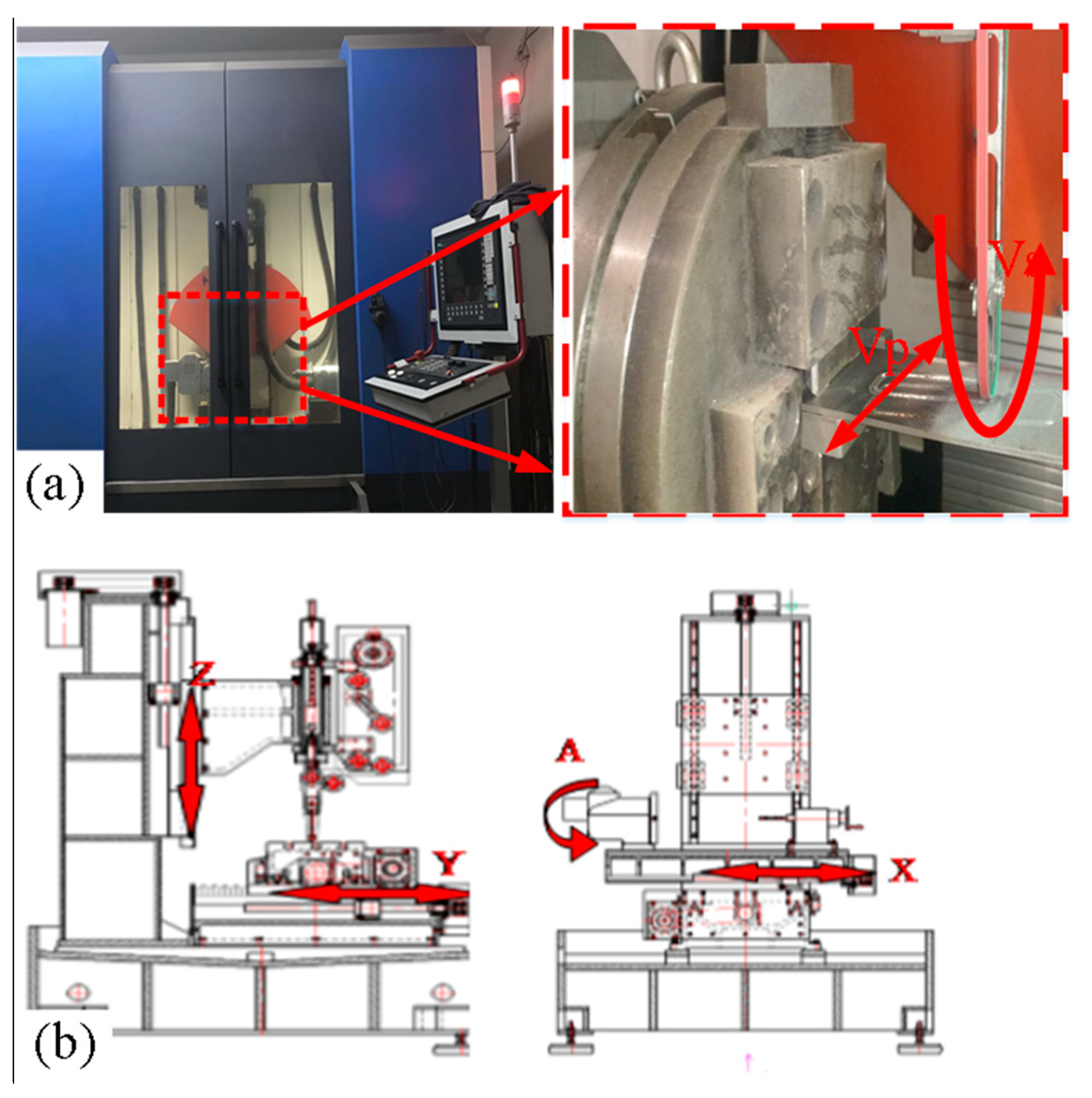

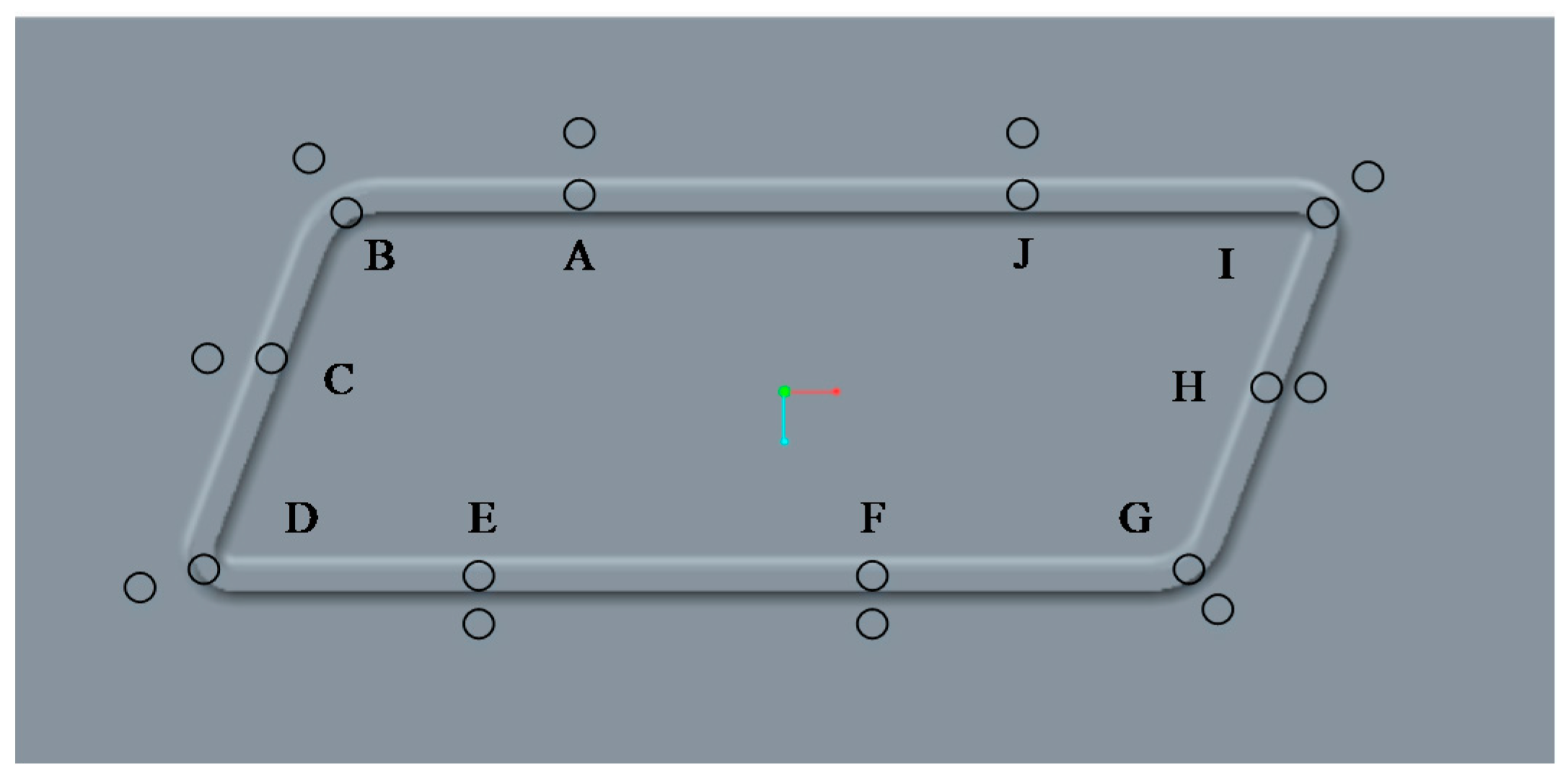

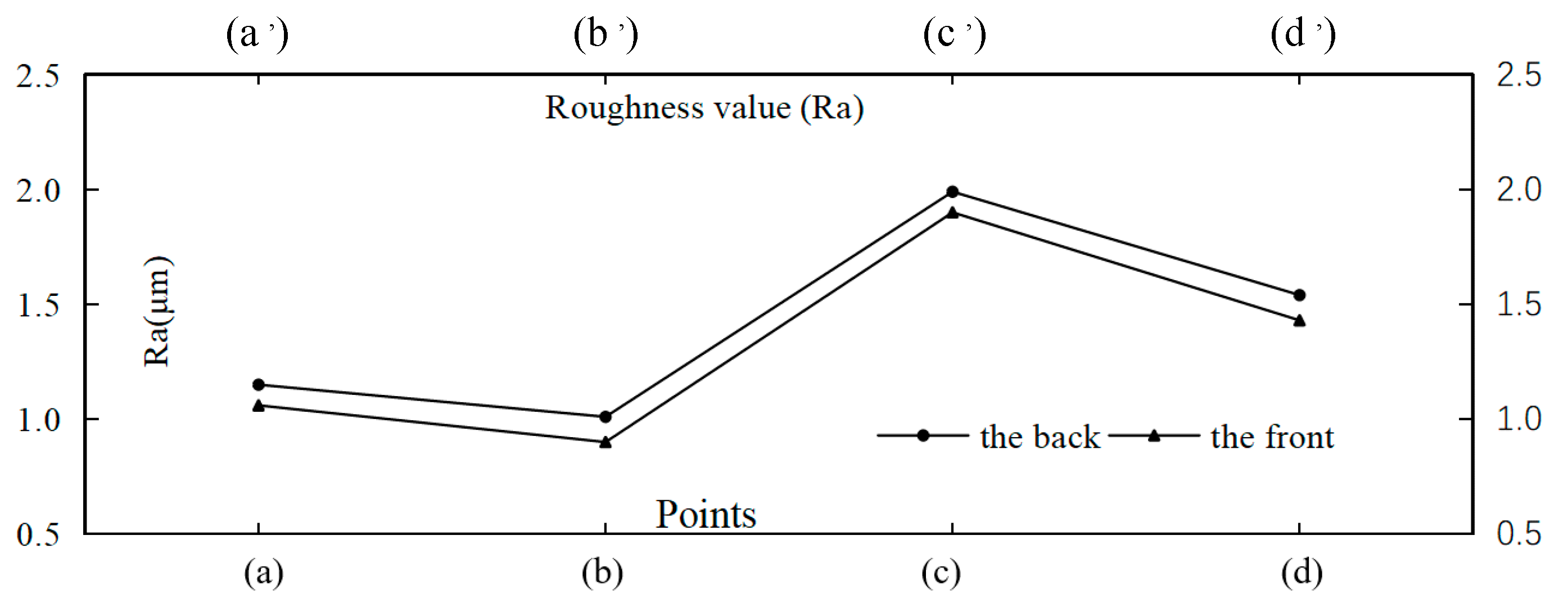
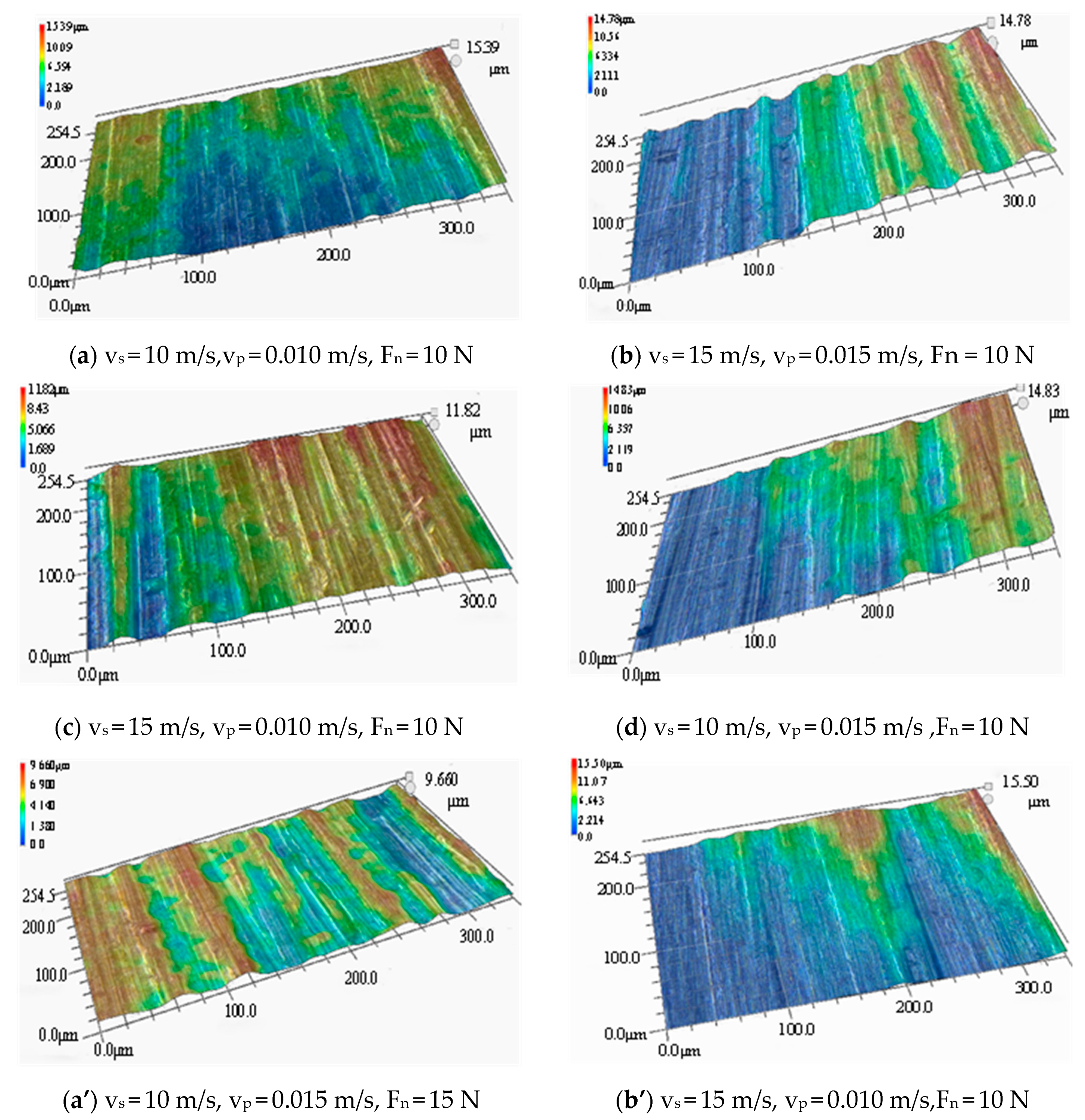
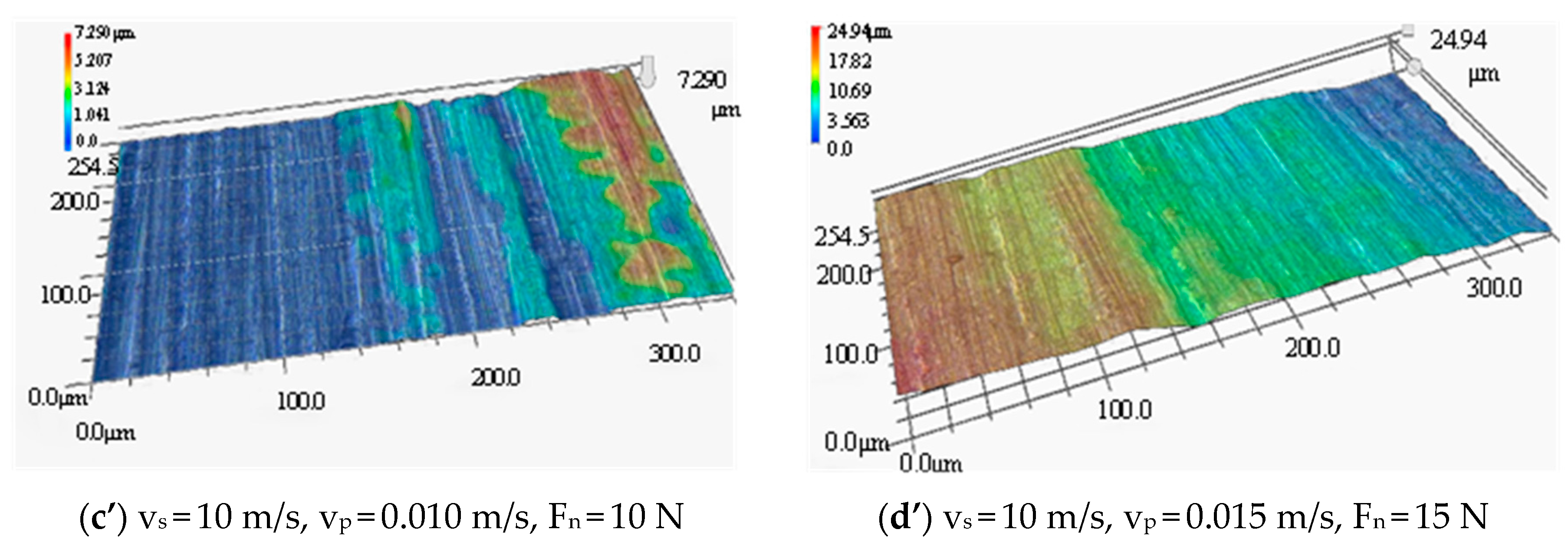
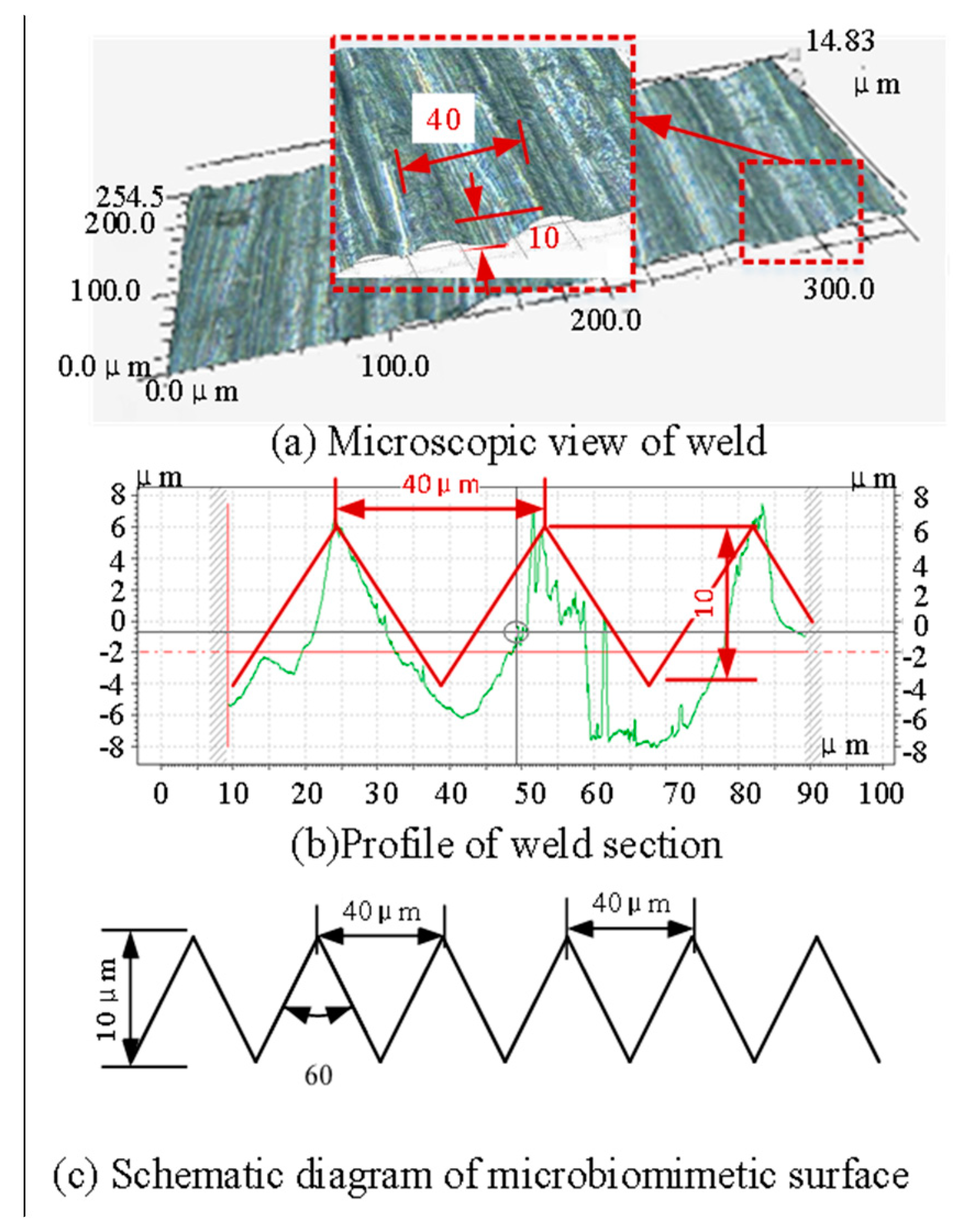


| Face Point | A | B | C | D | E | F | G | H | I | J |
|---|---|---|---|---|---|---|---|---|---|---|
| Height of weld face | 0.4 | 0.3 | 0.5 | 0.5 | 0.4 | 0.4 | 0.2 | 0.4 | 0.4 | 0.3 |
| Height of weld ridge | 0.8 | 0.9 | 0.9 | 0.6 | 0.6 | 0.5 | 0.8 | 0.5 | 0.7 | 0.8 |
| Project | Parameter |
|---|---|
| Belt width | 5 mm |
| Particle size | P200 |
| Feed mode | Longitudinal |
| Cooling mode | Air cooling |
| Contact wheel | Natural rubber |
| The Experimental Group | (a) and (a’) | (b) and (b’) | (c) and (c’) | (d) and (d’) |
|---|---|---|---|---|
| Belt speed vs(m/s) | 10 | 15 | 15 | 15 |
| Feed rate vp (m/s) | 0.010 | 0.010 | 0.015 | 0.015 |
| Grinding positive pressure Fn (N) | 10 | 10 | 10 | 15 |
© 2020 by the authors. Licensee MDPI, Basel, Switzerland. This article is an open access article distributed under the terms and conditions of the Creative Commons Attribution (CC BY) license (http://creativecommons.org/licenses/by/4.0/).
Share and Cite
Xiao, G.; Zhang, Y.; He, Y.; Huang, Y.; He, S.; Song, K. Bionic Structure on Complex Surface with Belt Grinding for Electron Beam Welding Seam of Titanium Alloy. Appl. Sci. 2020, 10, 2370. https://doi.org/10.3390/app10072370
Xiao G, Zhang Y, He Y, Huang Y, He S, Song K. Bionic Structure on Complex Surface with Belt Grinding for Electron Beam Welding Seam of Titanium Alloy. Applied Sciences. 2020; 10(7):2370. https://doi.org/10.3390/app10072370
Chicago/Turabian StyleXiao, Guijian, Youdong Zhang, Yi He, Yun Huang, Shui He, and Kangkang Song. 2020. "Bionic Structure on Complex Surface with Belt Grinding for Electron Beam Welding Seam of Titanium Alloy" Applied Sciences 10, no. 7: 2370. https://doi.org/10.3390/app10072370
APA StyleXiao, G., Zhang, Y., He, Y., Huang, Y., He, S., & Song, K. (2020). Bionic Structure on Complex Surface with Belt Grinding for Electron Beam Welding Seam of Titanium Alloy. Applied Sciences, 10(7), 2370. https://doi.org/10.3390/app10072370







